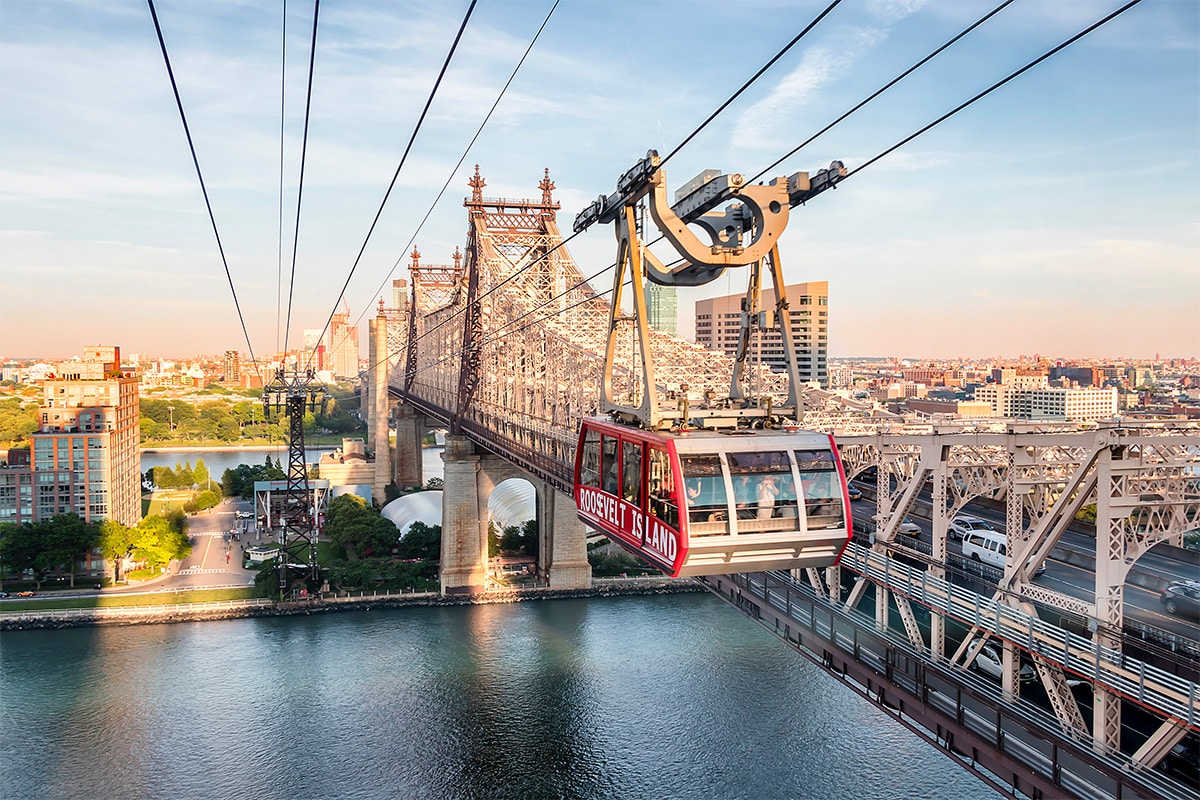New York is full of spectacular ways to admire its iconic skyline. Among them, one mode of transport stands out for its originality and the breathtaking views it offers: the Roosevelt Island Tramway. This cable car, linking Manhattan to Roosevelt Island, is not just a practical means of transport, but a genuine tourist attraction that promises an unforgettable experience for visitors in search of unique urban panoramas.
The New York Tramway
A technical feat in the heart of the Big Apple
The Roosevelt Island Tramway is much more than just a means of transport. It is a feat of engineering that soars above the bustling streets of New York, offering passengers an incomparable view of the city. Imagine flying over the urban jungle of Manhattan, the skyscrapers rising around you like giants of glass and steel, while theEast River sparkles below. This unique experience allows you to see New York from a completely different angle, away from the hustle and bustle of the crowded streets.
What makes this cable car so special is its harmonious integration into New York’s urban landscape. Unlike other cities, where cable cars are often associated with ski resorts or isolated tourist attractions, the New York cable car is an integral part of the urban fabric and everyday life of New Yorkers. It’s a perfect example of how New York manages to mix the useful with the pleasurable, transforming a simple journey into a memorable experience.
A journey through time
The history of the Roosevelt Island Tramway is as fascinating as the view it offers. Officially opened on Monday 17 May 1976, the cable car was originally conceived as a temporary solution to link Roosevelt Island to Manhattan. At the time, Roosevelt Island was undergoing rapid development, changing from an island mainly occupied by hospitals and institutions to a fast-growing residential area. The need for a fast and efficient link with Manhattan was crucial to attracting new residents and ensuring the success of this ambitious project.
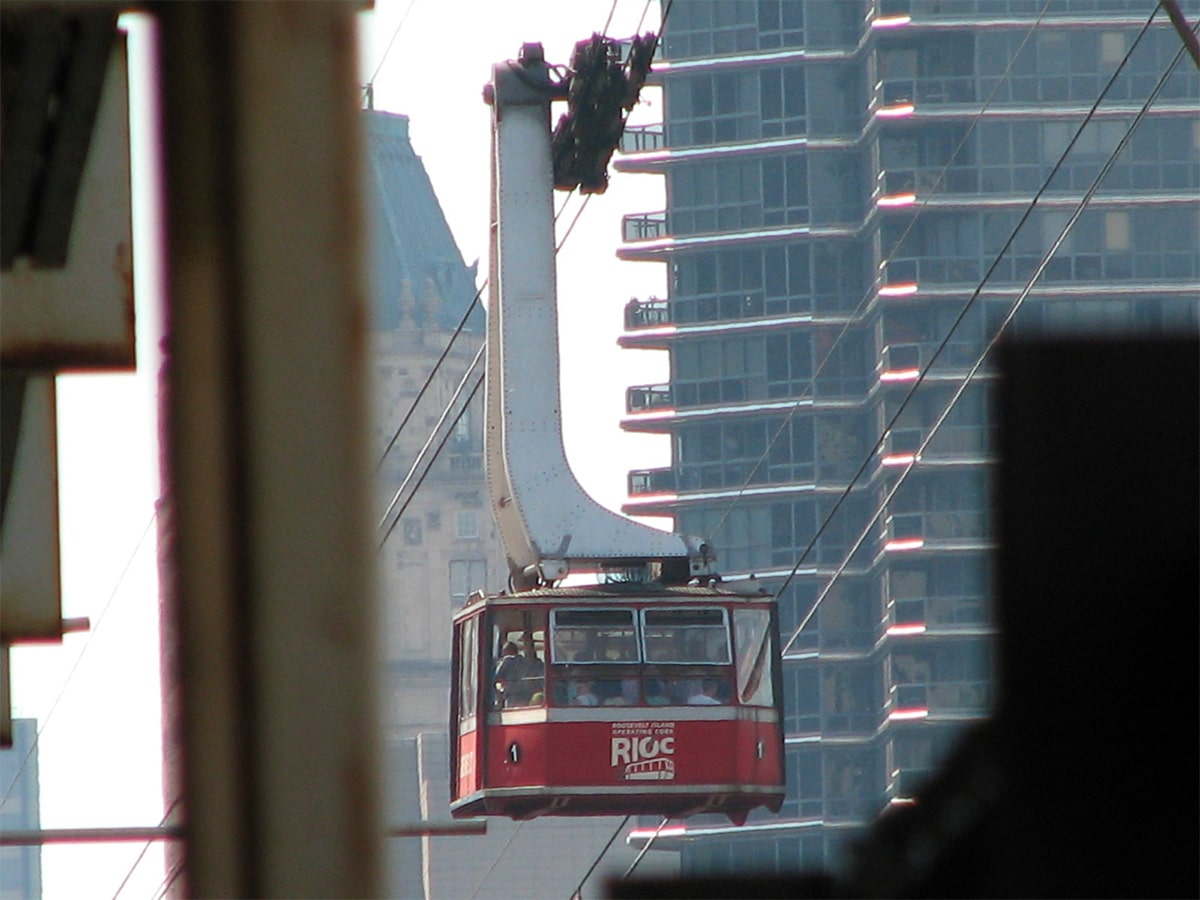
The cable car was built in record time and on a limited budget, reflecting the pragmatic and innovative spirit of New York. The aim was to provide a reliable means of transport while awaiting the completion of the F underground line, which was to link the island to the rest of the city’s transport network. What was intended as a temporary solution turned into a permanent attraction, loved by New Yorkers and tourists alike.
In 1989, when the underground’s F line was finally extended to Roosevelt Island, many thought the cable car would be dismantled. However, against all the odds, the decision was taken to maintain this unique mode of transport. This decision is a testament to New Yorkers’ attachment to this symbol of their city, but also reflects the practical nature of this means of transport, which offers a fast and picturesque alternative to the underground underground.
Over the years, the Roosevelt Island Tramway has undergone a number of modernisations to improve safety and comfort. In 2010, a major refurbishment was undertaken by French company Poma, replacing the original cabins with larger, more modern models. This upgrade has increased transport capacity to 110 passengers per vehicle and improved the reliability of the system, while preserving the charm and unique appeal of this transport experience. From now on, the 960 metres are covered at a speed of 8m/s, allowing a throughput of 1,500 passengers per hour.
How to make the most of your crossing
Essential practical information
To make the most of your experience with the Roosevelt Island Tramway, here is some essential practical information to know:
Station locations
In Manhattan
The departure point of the cable car is at Tramway Plaza, located at the intersection of 2nd Avenue and 59th and 60th Streets in Manhattan. This strategic location makes it easily accessible from several nearby underground stations, including the N, Q, R lines at Lexington Avenue/59th Street and the 4, 5, 6 line at 59th Street. Tip: if you’re visiting Central Park or shopping on 5th Avenue, the cable car is just a short walk away, making it a great break in your day of exploring.
On Roosevelt Island
The station is on the island itself, right next to the Roosevelt Island metro station (line F). Once you get off the cable car, you’ll be right in the heart of Roosevelt Island, on East Main Street.
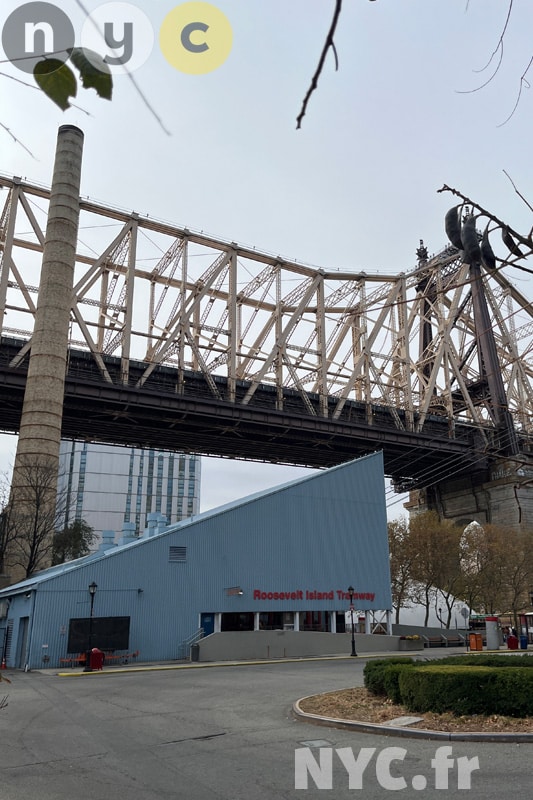
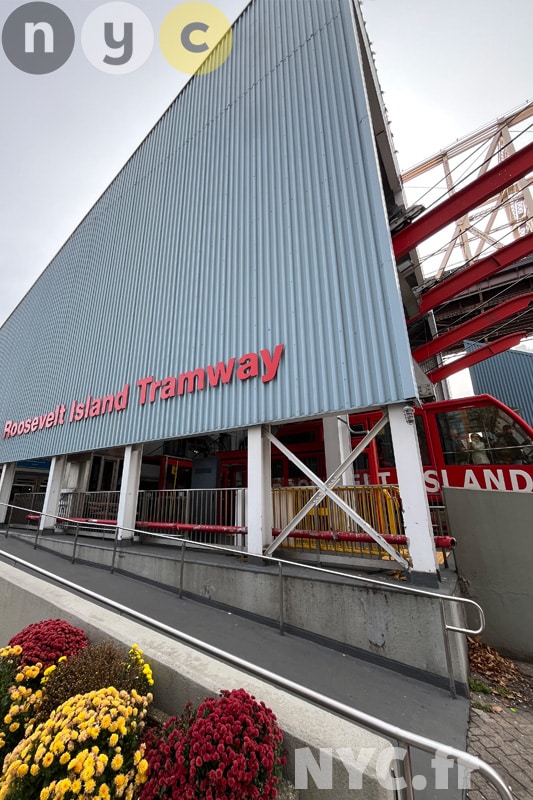
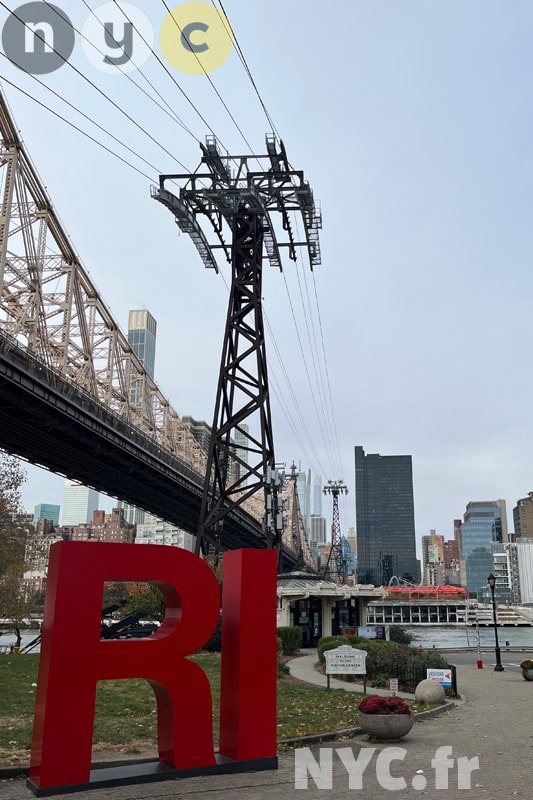
Fares
One of the best bits of news for visitors is that the Roosevelt Island Tramway is an integral part of New York ‘s mass transit system (MTA). This means that the cost of a journey is equivalent to that of a standard metro ticket. In 2024, the price of a single journey was $2.90. For a return journey, the price would be $5.80. But here’s a tip that will delight tourists: if you have opted for OMNY for more than $34, you pay nothing for 7 days, and the cable car ride is included at no extra cost. An excellent reason to include this experience in your itinerary.
Duration and frequency
The journey itself is surprisingly quick, lasting just 3 minutes. But don’t let that fool you: those 180 seconds are packed with spectacular views that will stay with you forever. The cabins leave every 7 to 15 minutes, depending on the time of day and how busy it is. At peak times, service is more frequent to accommodate Roosevelt Island residents travelling to and from work.
Operating times
The cable car operates every day of the week, with extended opening hours to suit the pace of New York life. From Sunday to Thursday, the service runs from 6am to 2am. On Fridays and Saturdays, to take advantage of the city’s lively nightlife, the cable car operates until 3.30am. These extended hours allow you to enjoy breathtaking night-time views of the illuminated Manhattan skyline.
Crowds and best times to visit
As with many attractions in New York, the timing of your visit can greatly influence your experience. Peak times, usually between 7.30am and 9.30am in the morning, and between 5pm and 7pm in the evening, see a large influx of Roosevelt Island residents on their way to or from work. If your aim is to make the most of the view and take unhurried photos, it’s best to avoid these times. Mid-morning and mid-afternoon on weekdays are often quieter and offer a more relaxing experience.
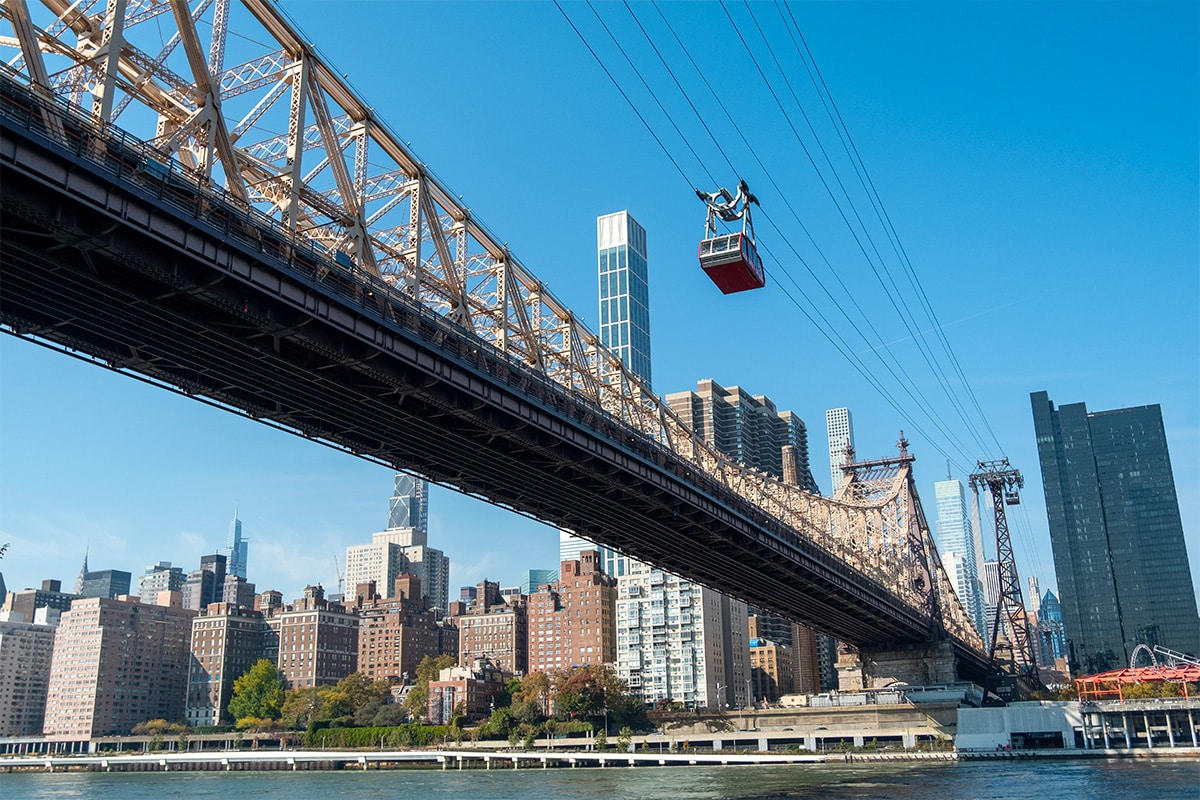
For photography enthusiasts, sunrise and sunset offer unique opportunities to capture the city in its best light. A tip: arrive about 30 minutes before sunset to make the round trip and enjoy the changing light on the skyline. Weekends, especially Sunday mornings, are ideal times for a leisurely journey, as the city slowly awakens before your eyes.
An incomparable visual experience
The Roosevelt Island Tramway offers much more than just a ride; it’s a true visual experience that takes you to the heart of one of the world’s most iconic cityscapes. From the moment the cab rises above the streets of Manhattan, every second of the three-minute journey becomes a feast for the eyes.
Iconic landmarks
As you soar higher, the skyscrapers of Midtown Manhattan rise majestically around you. Among the stars of this architectural spectacle, the Chrysler Building stands out with its gleaming Art Deco top. A little further on, the iconic Empire State Building dominates the skyline, recalling New York’s incredible history of verticality. These two giants of steel and glass are silent witnesses to the ambition and daring that characterise New York.
Unique panoramic views
As you rise, the Midtown skyline is revealed in all its splendour. This is your chance to spot other architectural gems such as One Vanderbilt, 432 Park Avenue and 30 Rockefeller Plaza. The view extends well beyond Manhattan, offering a glimpse of Queens and Long Island City, which are undergoing a major urban transformation.

One of the highlights of the journey is undoubtedly the uninterrupted view of the Queensboro Bridge, which you pass halfway along the route. This historic bridge, also known as the 59th Street Bridge, is an engineering masterpiece from the early 20th century. Seeing it from above allows you to fully appreciate its complex structure and its vital role in the city’s transport network.
The East River, New York’s vital artery
Crossing theEast River, you realise the crucial role this waterway plays in New York’s geography and history. The reflection of the sun on the water, the boats that ply the river, and the parks that line its banks provide a striking contrast to the urban density of Manhattan. It’s a reminder of New York’ s insular nature and its unbreakable link with the water.
A unique perspective on New York urbanism
What makes this experience truly special is the perspective it offers on New York’s urban layout. From this height, Manhattan ‘s famous chequered layout becomes apparent, with its avenues stretching northwards and its cross streets. It’s easy to see how the city has managed to maximise its limited space, creating a dense but organised urban landscape.
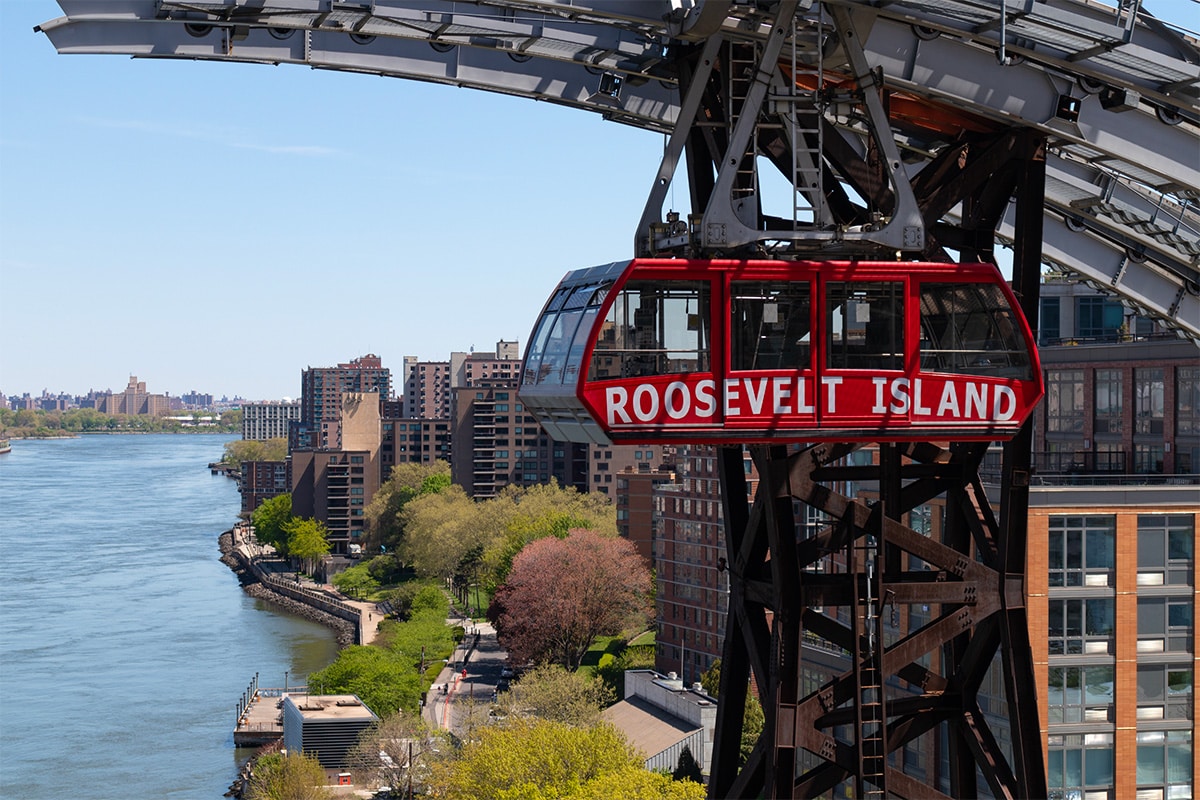
Height and sensation
At its highest point, the cable car reaches an impressive 76 metres above the ground. This elevation, though modest compared with skyscraper observatories such as Top of the Rock or One World Observatory, offers a totally different experience. The sensation of floating above the city, suspended between heaven and earth, is incomparable. It is this proximity to the urban environment, combined with the panoramic view, that makes the Roosevelt Island Tramway experience so unique.
A complete sensory experience
Beyond the visual, the cable car ride is a sensory experience in its own right. The gentle rocking of the cabin, the rustle of the wind, and the distant hum of the city below create a special atmosphere. It’s a moment of relative calm amid the hustle and bustle of New York, offering a contemplative break in your day’s sightseeing.
Roosevelt Island: a little-known destination to explore
Arriving on Roosevelt Island after this aerial crossing is like discovering a well-kept New York secret. This narrow strip of land, 3 kilometres long and 240 metres wide, nestled in the heart of theEast River, offers a radically different experience from the hustle and bustle of Manhattan.
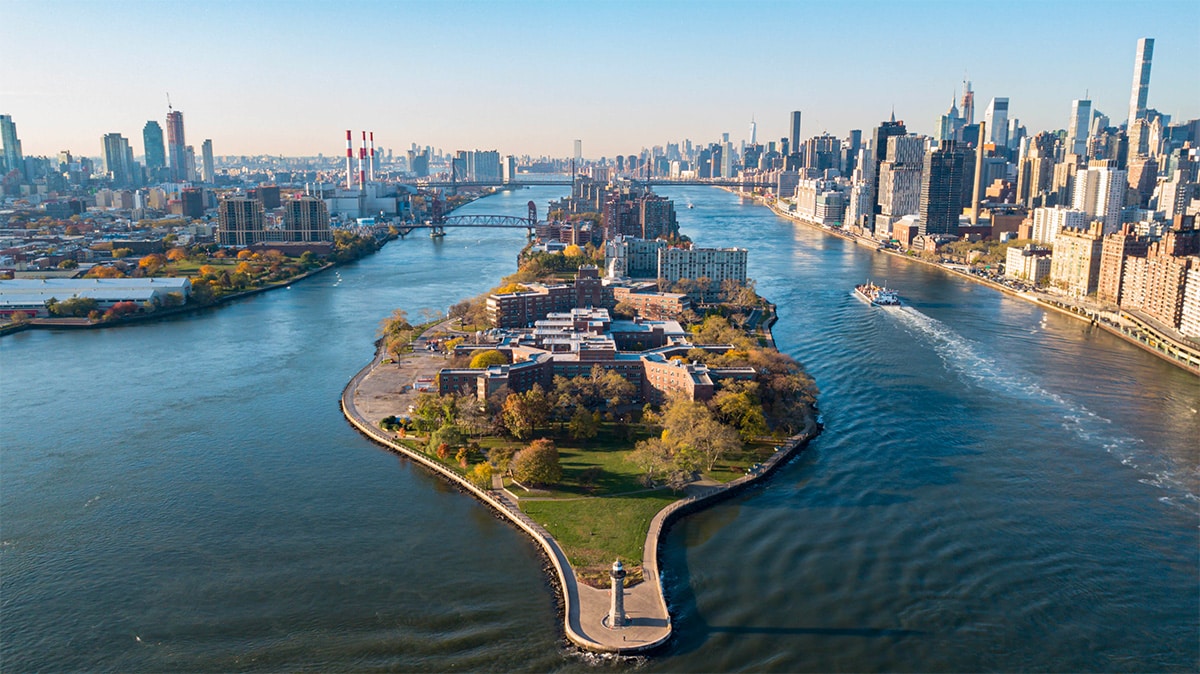
A haven of peace in the heart of New York
Roosevelt Island is characterised by its peaceful atmosphere and close-knit community. The vast green spaces, the walks along the shores and the relative absence of car traffic make it a popular place for New Yorkers to relax. For visitors, it’s a chance to see a quieter, more residential side of New York, far from the tourist clichés.
A rich and fascinating history
The island has undergone many transformations over the centuries. Once known as Blackwell’s Island, then Welfare Island, it was home to hospitals, asylums and even a prison. Today, these remnants of the past sit alongside modern residential developments, creating a unique urban landscape that tells the story of New York in a singular way.
Points of interest not to be missed
Among Roosevelt Island‘s must-see attractions, Franklin D. Roosevelt Four Freedoms Park stands out. Located at the southern tip of the island, this memorial to the 32nd President of the United States offers not only a beautiful architectural tribute, but spectacular views over Manhattan and Queens. The park, with its linden avenues and open-air ‘sitting room’ facing theEast River, is a place of peaceful reflection and contemplation.
Another fascinating site is the Smallpox Hospital, a ruined Gothic structure dating from the 19th century. Although inaccessible to the public for security reasons, its dilapidated walls provide a stark contrast to the modern skyscrapers in the background, creating an almost surreal atmosphere.
For history buffs, the Octagon Tower, the remains of a former lunar asylum transformed into a residential complex, is well worth a visit. Its unique architecture and intriguing past make it a symbol of the island’s renaissance.
Activities and leisure

Roosevelt Island is a paradise for walkers and joggers. The waterfront path around the island offers breathtaking views of Manhattan and Queens. It’s the ideal place for a leisurely stroll or a picnic overlooking the skyline.
Families will love the many parks and playgrounds scattered around the island. Southpoint Park, in particular, offers vast green spaces perfect for a moment of relaxation or an outdoor snack.
For a more local experience, the Saturday morning farmers’ market is an opportunity to sample fresh produce and mingle with the island’s residents. It’s a great way to support the local economy while enjoying the friendly atmosphere.
Insider tips for the best experience
To make the most of your visit to the Roosevelt Island Tramway and the island itself, here are a few insider tips:
Ideal timing
For the full experience, allow at least 2-3 hours for your excursion. This will allow you to ride the cable car there and back, explore Roosevelt Island’s main points of interest, and take time to enjoy the views without feeling rushed.
A typical itinerary might look something like this:
- Depart Manhattan by cable car (3 minutes)
- Visit Franklin D. Roosevelt Four Freedoms Park (30-45 minutes)
- Walk along the riverside path to the north (30 minutes)
- Break at Blackwell House or Octagon Tower (15-20 minutes)
- Return to the cable car station with a stop to admire the Smallpox Hospital (20 minutes)
- Return to Manhattan by cable car (3 minutes)
Photography
For photography enthusiasts, the cable car offers unique opportunities. The golden light of sunrise and sunset transforms the Manhattan skyline into a magical spectacle. To capture these moments at their best, opt for a camera with a wide-angle lens to capture the scale of the landscape. Don’t forget that cabin windows can create reflections; try to position your lens as close to the glass as possible to minimise this effect.
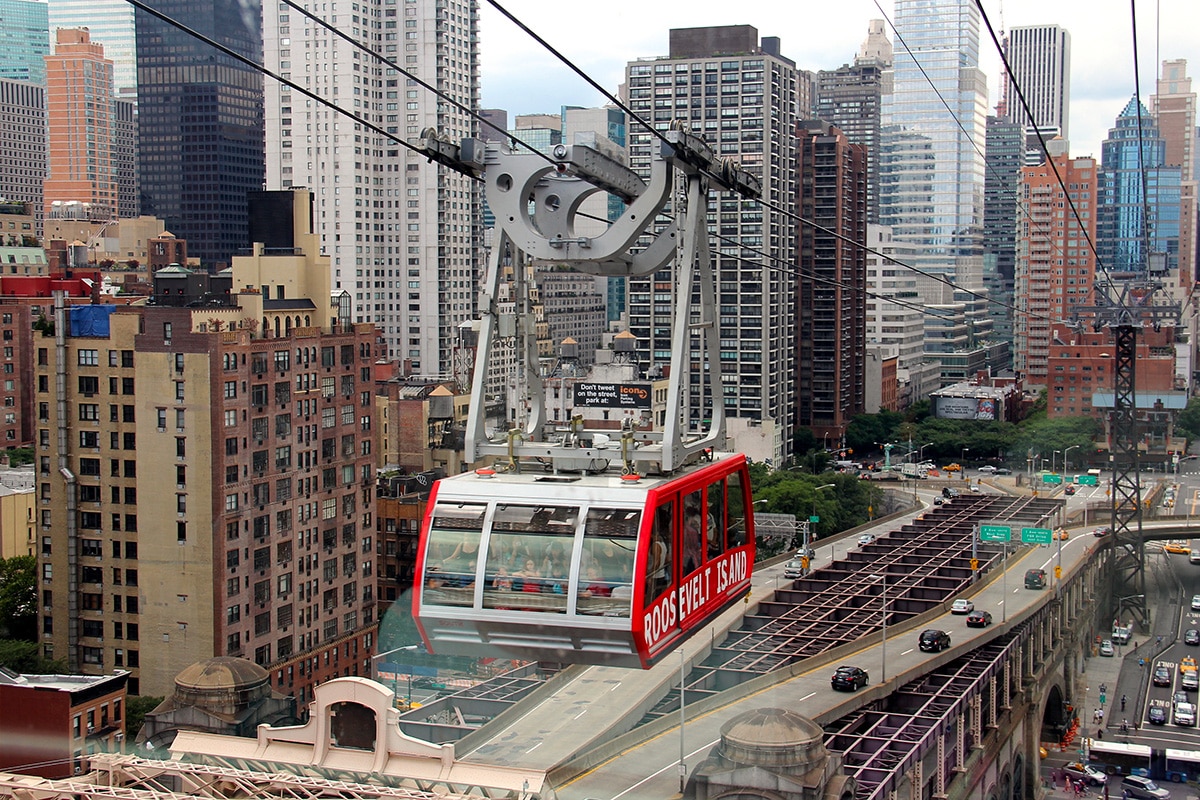
A tip for night shots: increase the ISO sensitivity of your camera and use a fast shutter speed to compensate for the movement of the cab. The lights of the city will naturally create spectacular streaks of light.
Accessibility
The Roosevelt Island Tramway is fully accessible to people with reduced mobility. The departure and arrival stations are equipped with lifts, and the cabins can comfortably accommodate wheelchairs. Roosevelt Island itself is relatively flat and has many paved paths, making it easy for everyone to explore.
Weather and seasons
Although the cable car operates all year round, the experience can vary considerably depending on the season. In summer, warm days offer clear views of the city, but the cabins can get hot at peak times. Autumn, with its bright colours in the surrounding parks, offers a striking contrast with the urban architecture. Winter can offer magical views of a snow-covered city, but make sure you dress warmly as the waiting platforms can be exposed to the wind.
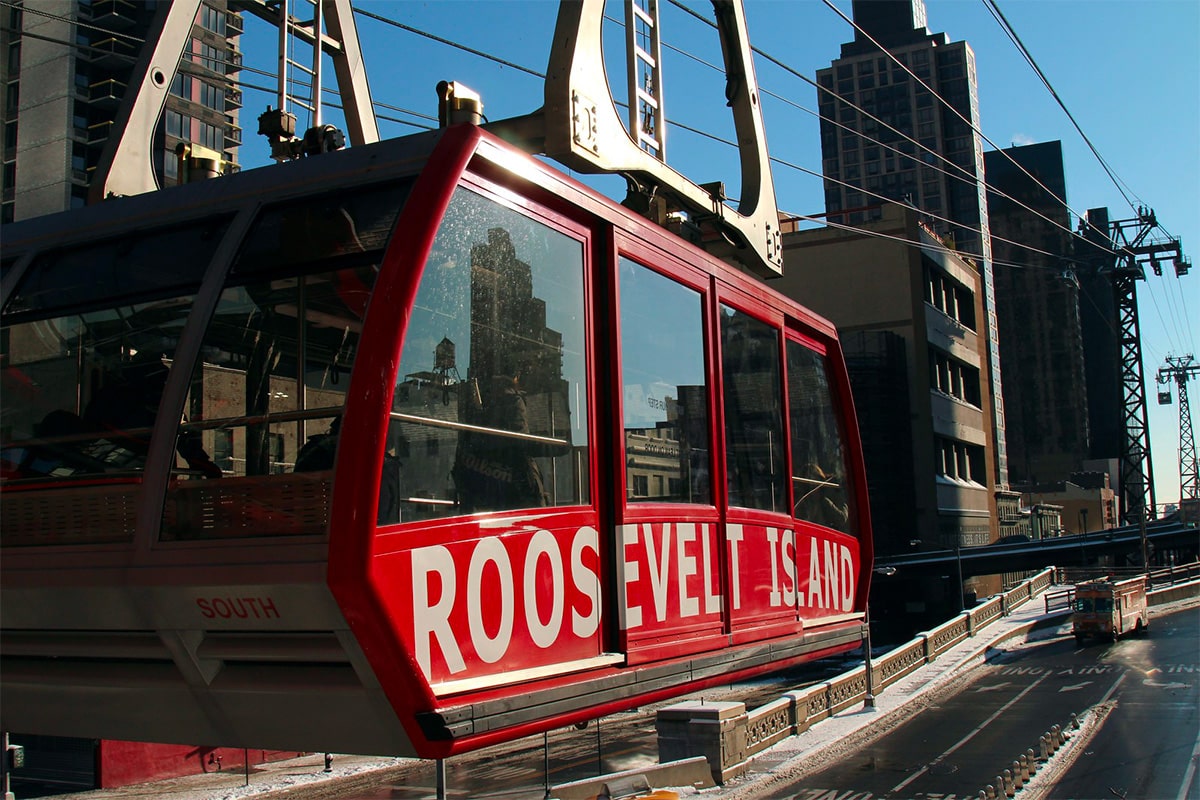
In the event of extreme weather conditions, such as strong winds or thunderstorms, the service may be temporarily suspended. Always check the weather conditions and the state of the service before your visit.
The cable car in popular culture
The Roosevelt Island Tramway is not just a practical means of transport or a tourist attraction; over the years it has become a veritable icon of popular culture, appearing in numerous films, TV series and video games. This media presence has helped to reinforce its status as a New York symbol, on a par with the Yellow Cab and the Statue of Liberty.
Memorable film appearances
One of the most iconic scenes featuring the cable car can be found in Sam Raimi’s film Spider-Man (2002). In a thrilling action sequence, Spider-Man saves Mary Jane and a group of passengers when the cable car is attacked by the Green Goblin. Not only did this scene provide moments of breathtaking suspense, it also solidified the cable car’s place in the collective imagination as an inseparable part of the New York landscape.
The cable car appears in other notable films such as City Slickers (1991), Dark Water (2005), and Now You See Me (2013), each time used to underline the unique and sometimes mysterious character of New York.
Television presence
In the world of TV series, the Roosevelt Island Tramway has made some notable appearances. The series White Collar has used it as a backdrop for dramatic scenes, while shows such as Law & Order and Person of Interest have incorporated the cable car into their complex New York plots.
In video games
Video game creators have also included this unique attraction in their virtual representations of New York. Grand Theft Auto IV, best known for its detailed recreation of New York (renamed Liberty City), includes a version of the cable car that players can ride. This inclusion in such a popular virtual world has helped to bring the cable car to an even wider international audience.
Anecdotes and facts
Over the years, the Roosevelt Island Tramway has been the scene of a number of unusual events that have made headlines. One of the most memorable occurred in 2006, when a power cut left passengers stranded for almost 12 hours above theEast River. This incident, although stressful for those involved, demonstrated the effectiveness of safety and rescue procedures, and led to significant improvements in the system.
In 2010, a man attempted to cross theEast River by walking on the cable of the cable car. Although this reckless attempt was quickly stopped by the authorities, it illustrates the attraction and mystery that this unique infrastructure continues to exert on the public imagination.
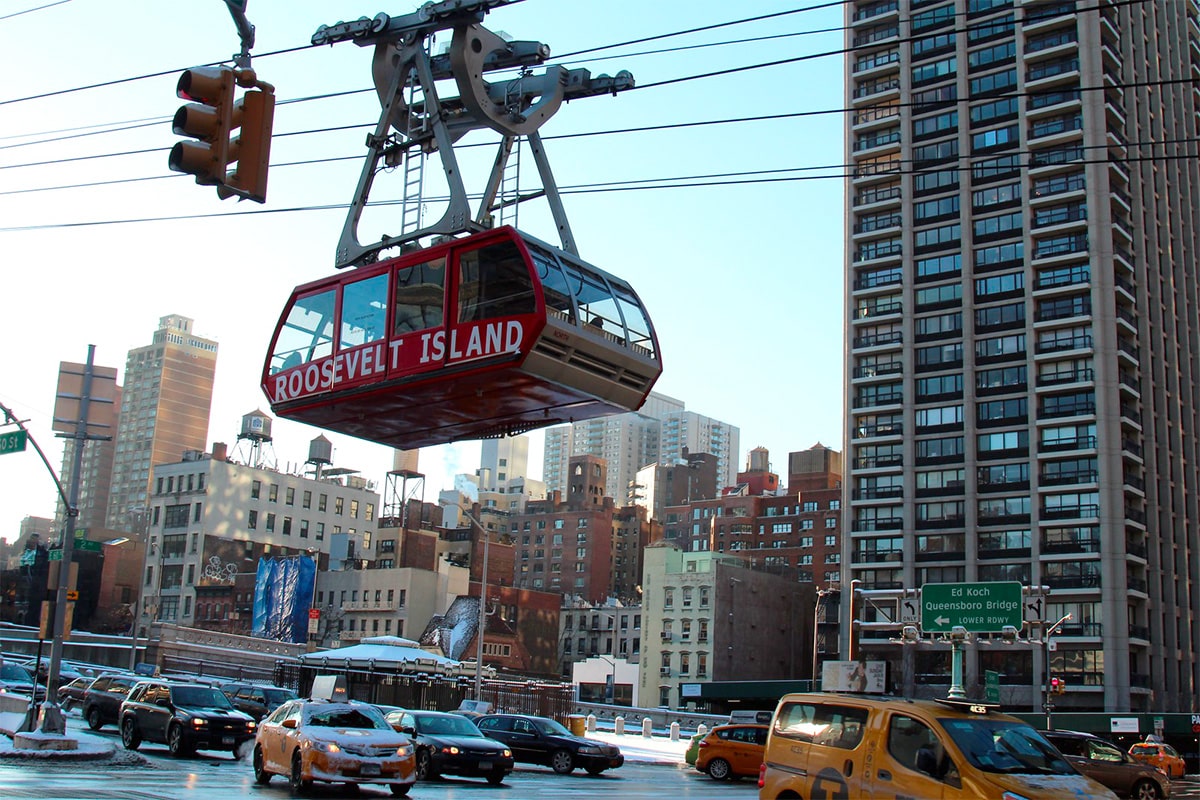
These appearances in popular culture and these anecdotes help to make the Roosevelt Island Tramway much more than just a means of transport. It is an integral part of New York’s identity, a symbol of the city’s ingenuity and resilience, and a continuing source of fascination for visitors from all over the world.
The Tramway: an experience not to be missed
The Roosevelt Island Tramway is much more than just a tourist attraction or a means of transport. It’s a unique experience that captures the very essence of New York: its innovation, resilience and ability to transform the everyday into something extraordinary.
For visitors, the three-minute ride offers an unrivalled perspective on the city, combining breathtaking views with a sense of urban adventure. It’s a chance to see New York from a new angle, to understand its geography and architecture in a way that few other experiences can.
The cable car’s ease of access, its integration into the city’s public transport system and its excellent value for money make it an attractive option for all types of traveller. Whether you’re a tourist looking for a unique panoramic view, a photographer in search of the perfect shot, or simply someone who wants to experience New York like a local, the Roosevelt Island Tramway has something to offer.
Don’t forget that the experience isn’t limited to the cable car ride. Roosevelt Island itself is well worth exploring, offering a stark contrast to the hustle and bustle of Manhattan. It’s a chance to discover a quieter, more residential side of New York, while enjoying breathtaking views of the skyline.
So next time you visit New York, take the time to include the Roosevelt Island Tramway in your itinerary. This short journey over theEast River will leave you with lasting memories and a new appreciation of the diversity and beauty of the city that never sleeps. It’s an opportunity to see New York with fresh eyes, to take a step back (literally) from the hustle and bustle of the city, and to enjoy an experience that perfectly embodies the innovative and daring spirit of this extraordinary city.
